The Doomsday Clock places humanity 90 seconds away from the apocalypse
The war in Gaza and the rise of AI, among other threats, made the Bulletin of Atomic Scientists leave the symbolic time as close to midnight as last year: ‘Make no mistake: this is not an indication that the world is stable’

There are 90 seconds left until the end of the world. Before running to the nuclear shelter, you should know that, as disturbing as it sounds, this is nothing more than a symbolic calculation carried out each year by a committee convened by the Bulletin of the Atomic Scientists. It is one of those January traditions, such as the commitment to abstain from alcohol (Dry January) or the claim that the third Monday in January is the most depressing day of the year (Blue Monday), that make the first month of the year such an uphill struggle. In this particular case, experts reveal how close they think humanity is to its own doom by setting the Doomsday Clock closer or further from midnight. The closer it is, the less time there is until the end of the world. The good news is that the hands remain at 90 seconds to midnight, same as last year. The bad news: 2023 was the most worrying on record since the clock was started back in 1947.
The reasons for concern? At the presentation on Tuesday, the custodians of the hands of the apocalypse cited the rise of artificial intelligence, the proliferation of nuclear weapons, the war between Russia and Ukraine and the one waged by Israel in Gaza, biological threats, the climate crisis and rampant disinformation promoted in many cases by states themselves. The event, which began, alas, late, featured the popular science communicator Bill Nye and Rachel Bronson, president and CEO of the Bulletin of the Atomic Scientists. She explained that the aim is to answer two questions: “Is humanity safer or at greater risk this year than last year?” And: “Is humanity safer or at greater risk this year, compared to the more than 75 years we have been conducting this exercise?”
Not a stable world
“Make no mistake: resetting the Clock at 90 seconds to midnight is not an indication that the world is stable. Quite the opposite. It’s urgent for governments and communities around the world to act,” warned Bronson. “The Bulletin remains hopeful — and inspired — in seeing the younger generations leading the charge.”
These apocalypse watchmakers often receive criticism for their alarming messages, but they note that this is precisely what it is all about: alerting humanity of the dangers that threaten it. The group is made up of top-level experts, including Nobel Prize winners, who lend themselves to a game of hypotheses that began shortly after the first atomic bombs and several members of the Manhattan Project launched the Bulletin.
In 2018, the clock struck 11:58 p.m. The world had never been so close to midnight, except on one occasion: in 1953 when the United States and the Soviet Union were in the middle of an arms race with thermonuclear bombs. Since that record six years ago, there has been one milestone after another. In January 2020, the Doomsday Clock was set at 100 seconds to midnight. Then, the coronavirus pandemic hit (and the clock did not move), and later, there was a war in Europe, which made the clock move to 90 seconds to midnight in 2023, another record.
In its first edition, in 1947, it was set at seven minutes to midnight. Since then, it has moved 25 times while becoming a reference in popular culture, thanks to its cameos in films such as Dr. Strangelove or How I Learned to Stop Worrying and Love the Bomb, by Stanley Kubrick, or in Smashing Pumpkins songs. The most optimistic time marks came in the early 1990s, with the fall of the Soviet bloc and the Berlin Wall. In 1991, the hands were set at 17 minutes to midnight, seven minutes earlier than the previous year. Since then, and with the exception of 2009 and 2010, the clock has not stopped edging closer to doomsday. In 2007, climate change was included as a serious danger for humanity and this factor has not ceased to give rise to bad omens in all these years.
Sign up for our weekly newsletter to get more English-language news coverage from EL PAÍS USA Edition
Tu suscripción se está usando en otro dispositivo
¿Quieres añadir otro usuario a tu suscripción?
Si continúas leyendo en este dispositivo, no se podrá leer en el otro.
FlechaTu suscripción se está usando en otro dispositivo y solo puedes acceder a EL PAÍS desde un dispositivo a la vez.
Si quieres compartir tu cuenta, cambia tu suscripción a la modalidad Premium, así podrás añadir otro usuario. Cada uno accederá con su propia cuenta de email, lo que os permitirá personalizar vuestra experiencia en EL PAÍS.
¿Tienes una suscripción de empresa? Accede aquí para contratar más cuentas.
En el caso de no saber quién está usando tu cuenta, te recomendamos cambiar tu contraseña aquí.
Si decides continuar compartiendo tu cuenta, este mensaje se mostrará en tu dispositivo y en el de la otra persona que está usando tu cuenta de forma indefinida, afectando a tu experiencia de lectura. Puedes consultar aquí los términos y condiciones de la suscripción digital.










































